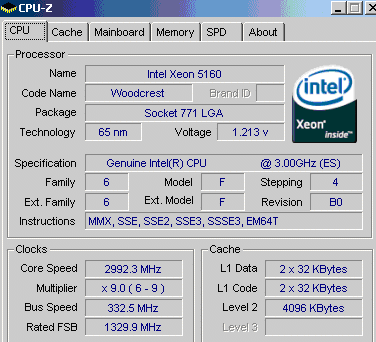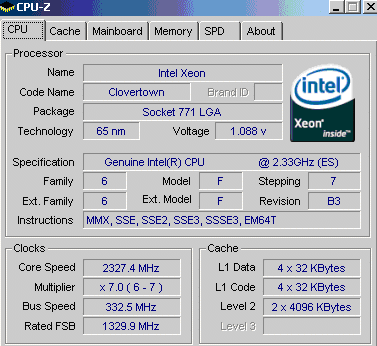Quad Core Intel Xeon 53xx Clovertown
by Johan De Gelas on December 27, 2006 5:00 AM EST- Posted in
- IT Computing
Introduction
The Xeon 5160 (a.k.a. Woodcrest) is probably the best server chip Intel has made in the past decade. It delivers high IPC, high (3GHz) clock speed and a surprising low 80W TDP for a dual core design. But Intel's engineers saw that the fastest Woodcrest could score twice for Intel, in a slightly different form... or should we say package. Lower the voltage of a 3GHz from about 1.21 V to slightly less than 1.1V and you can only achieve 2.33GHz. However by running at 2.33GHz and 1.1V, Intel was able to cut the TDP in half. Now place two of these low voltage Xeons in one package and you get a 2.33GHz quad core Xeon and an 80W TDP. This is the essence of the CPU that bears the codename "Clovertown".


The quad core Xeon runs at less than 1.1V
The really weird thing about all this is that Intel sells those two Xeon 5160 chips with lower voltage for the same price as one of the higher clocked chips. A 2.33GHz quad core Xeon DP costs the same as a 3GHz dual core Xeon DP ($851), and a 1.86GHz quad core will cost as much as a 2.66GHz dual core. In other words, Intel is willing to give one chip "for free" just to "ignite the quad core era".
Intel is also trading in (theoretically almost 30%) single threaded performance for more multi-threaded processing power while keeping the power envelope the same. It is not as radical as Sun's T1, but the philosophy behind it is more or less the same. Is it a good bet? Well, being first to market with a quad core x86 product will probably make a big impact. It should be especially interesting for HPC and rendering applications. If you need the power of four cores in a blade server, the 65nm Clovertown or Xeon 53xx is the ideal CPU for the very crammed, "hard-to-cool" housing.
The Xeon 53xx - with the appropriate BIOS update - should have drop-in capability in 5000(x) based chipset boards. The availability of Xeon 53xx generates some very interesting choices for the server buyer. With 8 cores on a dual socket system, can it replace the more expensive quad socket systems such as those based on the Opteron 8 series or the recently launched Xeon 71xx CPUs? Should you go for a high clocked dual core Xeon or a lower clocked quad core Xeon? The "standard" answer is that it depends on the application, but that answer is boring and hardly informative. In this article we will try to give an answer to these questions as they apply to Rendering, OpenSSL, Java, SAP and MySQL applications. Jason and Ross are busy with the SQL Server benchmarks, so you can expect even more benchmarks soon.
The Xeon 5160 (a.k.a. Woodcrest) is probably the best server chip Intel has made in the past decade. It delivers high IPC, high (3GHz) clock speed and a surprising low 80W TDP for a dual core design. But Intel's engineers saw that the fastest Woodcrest could score twice for Intel, in a slightly different form... or should we say package. Lower the voltage of a 3GHz from about 1.21 V to slightly less than 1.1V and you can only achieve 2.33GHz. However by running at 2.33GHz and 1.1V, Intel was able to cut the TDP in half. Now place two of these low voltage Xeons in one package and you get a 2.33GHz quad core Xeon and an 80W TDP. This is the essence of the CPU that bears the codename "Clovertown".


The quad core Xeon runs at less than 1.1V
The really weird thing about all this is that Intel sells those two Xeon 5160 chips with lower voltage for the same price as one of the higher clocked chips. A 2.33GHz quad core Xeon DP costs the same as a 3GHz dual core Xeon DP ($851), and a 1.86GHz quad core will cost as much as a 2.66GHz dual core. In other words, Intel is willing to give one chip "for free" just to "ignite the quad core era".
Intel is also trading in (theoretically almost 30%) single threaded performance for more multi-threaded processing power while keeping the power envelope the same. It is not as radical as Sun's T1, but the philosophy behind it is more or less the same. Is it a good bet? Well, being first to market with a quad core x86 product will probably make a big impact. It should be especially interesting for HPC and rendering applications. If you need the power of four cores in a blade server, the 65nm Clovertown or Xeon 53xx is the ideal CPU for the very crammed, "hard-to-cool" housing.
The Xeon 53xx - with the appropriate BIOS update - should have drop-in capability in 5000(x) based chipset boards. The availability of Xeon 53xx generates some very interesting choices for the server buyer. With 8 cores on a dual socket system, can it replace the more expensive quad socket systems such as those based on the Opteron 8 series or the recently launched Xeon 71xx CPUs? Should you go for a high clocked dual core Xeon or a lower clocked quad core Xeon? The "standard" answer is that it depends on the application, but that answer is boring and hardly informative. In this article we will try to give an answer to these questions as they apply to Rendering, OpenSSL, Java, SAP and MySQL applications. Jason and Ross are busy with the SQL Server benchmarks, so you can expect even more benchmarks soon.










15 Comments
View All Comments
zsdersw - Friday, December 29, 2006 - link
Smithfield/Paxville is a MCM chip (two pieces of silicon in one package), as well.
Khato - Wednesday, December 27, 2006 - link
Agreed on it being quite the good review, save for the lack of power consumption numbers/analysis. Form factor and power consumption can be just as important as the performance when the application can be spread across multiple machines, now can't it? At the very least, it would be nice to link to the power consumption numbers for the opteron platform in the first review it showed up in (which puts the dual clovertown at 365W load, while the quad 880 is supposedly 657W load.)rowcroft - Wednesday, December 27, 2006 - link
Loved the article, great job.I'm in the process of purchasing two dual quad core servers for VMWare use. Looking at the cost to performance analysis, it would be worth mentioning that many of the high end applications are licensed on a per socket basis. This alone is saving us $20,000 on our VMWare license and making it a compelling solution.
I would love to see more of this type of article as well- very interesting and not something you can easily find elsewhere on the net. (Tom's hardware reviewed the chip running XP Pro!)
duploxxx - Friday, December 29, 2006 - link
If you think that reading this review will help you to decide what to buy as VMWARE base you are going the wrong way! Yes these small tests are in favor for the new MCW architecture as we saw before and since haevy workload seems hard to test for some sites like anand! keep in mind that VMWARE is heavy workload, you combine the cpu and ram to whatever you want, guess what the fsb can't be combined like you wish!thinking that a 2x quad will outperform the 4p opteron is a big laugh! the fsb will kill youre whole ESX instantly from 4+ os on your system with normal load.
the money you save is indeed for sure, the power you loose is an other thing!
friendly info from a certified esx 3.0 beta tester :)
Viditor - Wednesday, December 27, 2006 - link
Probably one of your most thorough and well-rounded articles Johan...many thanks!It was nice to see you working with large (16GB) memory.
If you do get a Socket F system, will you be updating the article?